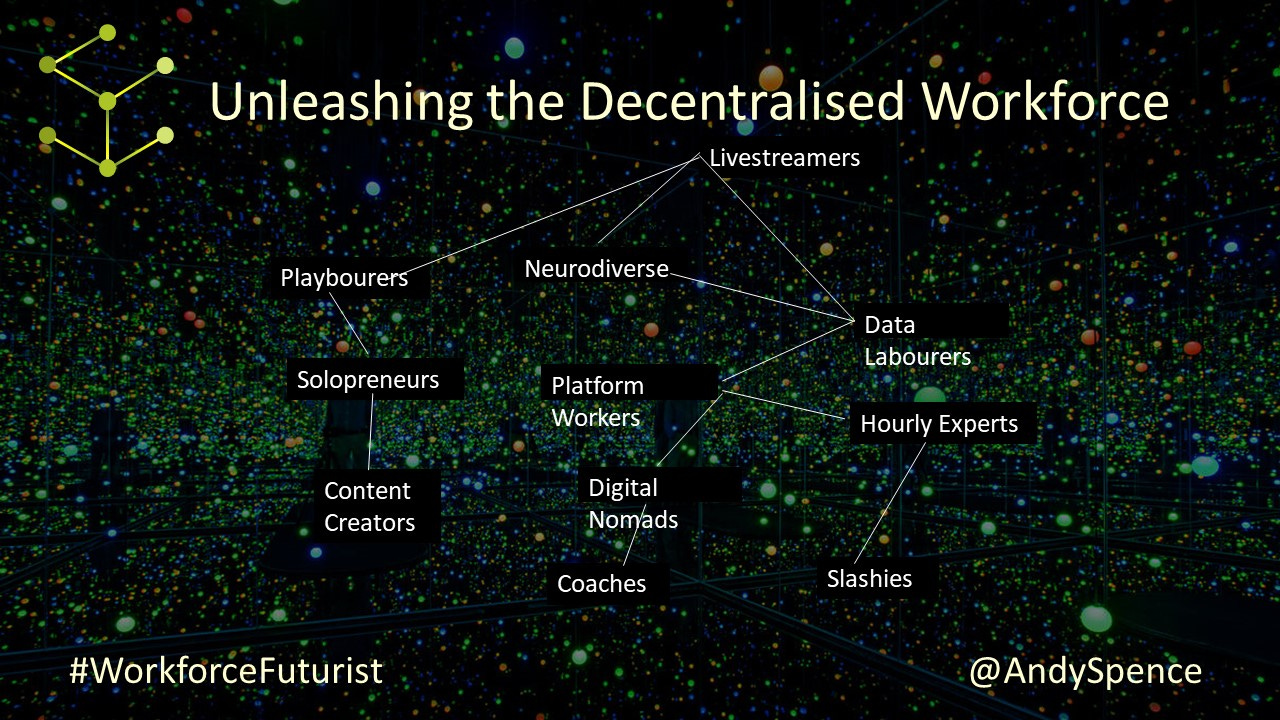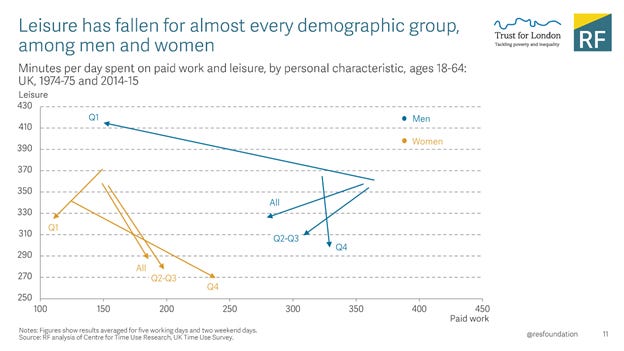Unleashing The Decentralised Workforce
An untapped workforce will utilise digital infrastructure to achieve its economic potential outside of traditional employment, changing the nature of work, the firm, careers, education and welfare.
This article is the first from the new Workforce Futurist Newsletter and asks some key questions for workforce futurists.
The pandemic has exposed the fault lines in our societies, in governance, trust, infrastructure, and the inequalities in gender, race, and age. Some 40-50% of workers around the world are currently able to work from home and there is talk of a remote work revolution.
The physical location of some work has changed, but the organisation of that work is still very much centralised. Any substantial organisational change needs to be much deeper than just location.
A new decentralised workforce will emerge from the rubble of defunct 20th century organisational structures. This will unleash the economic and social potential of people and help to solve our current social, climate and economic problems.
There are many ways to earn and learn in 2020 - from labourers to playbourers, carers to sharers, preachers to teachers, and tippers to strippers. A job contract with the associated boss, fixed hours, and salary is not the answer for everyone.
53% of the world’s working-age women are not in the labour force. (Source - International Labour Organization)
Economists might categorise them as ‘inactive’ but these people DO work - it’s just not recognised or monetised. Employment patterns are changing, work is here to stay but in different forms.
The biggest reduction of poverty in history has been with 600m Chinese workers joining the global economy since the 1980s. Now we have another massive economic and societal opportunity to include an extended workforce. This untapped resource is a big opportunity to boost the global economy and improve social justice.
This massive inclusion of the global workforce is enabled by freely available tools and technology, including mobile, video, social media, AI and blockchain.
As jobs are unbundled into tasks, work will be reconstituted into new forms empowering a more diverse group of workers to reach their potential. New types of organisations, markets, platforms, and work ecosystems will evolve that are better suited for our needs in the Digital Covid Age (DC Age).
Pandemic Workforce Blues
In the pandemic governments around the world had to find ways to pay workers wages through furlough, or kurzarbeit schemes. In the UK, the complexity of paying some 1.7million self-employed workers surprised many.
The crypto community have a mantra,
Bank the unbanked
with 1.7 billion adults without access to banking facilities in 2018,
the mantra today should be,
Pay the unPaid
We may be moving out of crisis management into the comforting new cliché of the ‘new normal’.
All that is normal about our new situation, is how we think.
Initial reactions to the impact of the pandemic on work have focused on the joys of home-working, disdain for offices, and ‘zoom call overload.’
The proposal for a four-day work week delights many, but is just as prescriptive and constraining as well the five-day week.
We Can’t Predict the Future of Work
As we watch the geopolitical ramifications of USA vs China playing out, the ongoing battle between Capital and Labour, and supply and demand chasing each other like dogs in the park. What can we really predict about our future economies?
So zooming beyond the fact that some of us have been able to work remotely, the long-term impact on the workforce will come towards the latter phases of industry restructuring – bankruptcies, bail-outs, mergers and acquisitions, then supply-chain reinvention and re-vamped products and services.
Labour economists build predictive mathematical models on the future workforce based on a set of core assumptions. They are always wrong, but that’s not the point as they are useful.
Economic models on the future of work do not sufficiently take into account how the workforce has changed in the internet era. They cannot account for the impact of upgrading our current inefficient work-matching systems and of course economic black swans, like the pandemic.
[Source - Resolution Foundation]
The internet has given us so many more options when it comes to fulfilling our need to play, to shop, to socialise and for entertainment. It offers us new routes to status, friendships, and meaning that work has done in the past. From learning to earning to virtue signalling, the internet provides a continuous competitive market for our attention. The overlap between entertainment, learning and work will play out in interesting ways in the 2020s.
As always, the macro-economic drivers will shape how we work, not what Google did in 2015, or the latest marketing push from big technology.
For employers, new workforce strategies will emerge, in the context of localised job-market supply and demand. It will be these dynamics that dictate HR and management practices, not the new apps.
Before we can predict what work will look like in the future, we need to redefine work.
The Decentralised Workforce – From Labourers to Playbourers
Work = any activity performed by persons of any sex and age to produce goods or to provide services for use by others or for own use.
Work is a defining human characteristic. There is also a huge demand and opportunity for people to work outside formal paid employment. I will leave others to try and quantify this opportunity, but this is a multi $ trillion market.
As Li Jin describes,
Employment at a company is itself a bundle of various services and infrastructure, and micro-entrepreneurs piece these together on their own.
As work unbundles, it will rebundle in different forms.
An emerging globally decentralised workforce extends well beyond traditional concepts of jobs and organisations, and includes:
The Gig Workers - the gig economy is not well regarded by some due to well-documented issues of exploitation of its employees/independent contractors (choose preferred term). Although these objections do tend to be temporarily suspended when taking a VC subsided ride-share or receiving a warm meal to the front door. In the USA, up to one in seven working-age adults have worked via a platform at some point. The gig economy is not new or well defined but includes artists, on-call workers, contractors, seasonal workers, and even a few consultants.
The Slashies as in
“I love being a Writer/Speaker/Advisor/Coach/Curator/Activist/Slashie”
Those working across different types of jobs to make a living.
The Unpaid Workers - if American women earned minimum wage for the unpaid work they do around the house and caring for relatives, they would have made $1.5 trillion last year. This includes time spent doing routine housework, shopping for necessary household goods and child care. As a society, we need to recognise the kind of work that supports our collective well-being. I shall leave the mechanisms of that for another day.
The Playbourers – as you might have guessed, this term is a hybrid for of play and labour. Found specifically in the digital games industry. We have YouTuber influencers and modders getting paid to play games. And for Animal Crossing fans, you will know that ‘At Nook's Cranny, a white and pink ‘Cute Vanity’ sells for 5,400 bells’ where you can make a buck trading on the black market. Watch out for new virtual economies being built by the generation brought up on Minecraft, Tik Tok and Fortnite.
Greater inclusion of the Neurodiverse Workforce - up to 80% of individuals on the autism spectrum do not have a job. Job interviews are a weak predictor of subsequent job performance and introduce bias, and for autistic people, interviews can be a nightmare. The decentralised workforce includes a more neurodiverse group of workers, using platforms and employment practices including in the technology industry.
The Bounty Hunters – with a neat idea, the Bounties Network used tokens to incentivise the clean-up of plastic pollution in the Philippines, $700 for about three metric tonnes of plastic waste removal.
The Livestreamers are broadcasting user-created video in real-time like on gaming platforms such as Twitch, or non-gaming like Caffeine for interactive shows. Some popular individual content creators are being paid $500k/month, with most it might be more like $500 as a hobby or additional income stream.
The Exhibitionists - as millions of people filed for unemployment last month, OnlyFans, adult-only platform, reported 150,000 new users creating accounts daily with some performers reportedly earning $200k/year. It’s only a small step from doing Zoom calls in your PJs I suppose 😉.
The Content Creators - it is estimated that those producing comics, photographs, and stories on Patreon paid its members approximately US$1 billion in 2019, with more than 50,000 creators joining since mid-March. Writers are also paid with subscriptions on SteamIt, Medium, and Substack for newsletters.
The Teachers and Coaches – nearly 500 course creators on Teachable make more than $100k/year. Outschool, an online marketplace for live video classes in which teachers are predominantly former school teachers and stay-at-home parents.
The Platform Workers - you are familiar with platform-driven gig work, such as Lyft, Uber, TaskRabbit. Upwork has reported services volume up 15% year-over-year, and its research shows Remote Work has risen rapidly as a result of the pandemic according.
The Data Labourers – we benefit from using services such as Google search or maps, or Facebook messenger. We don’t pay for these services directly with cash, but there is a catch,
These companies are mainly funded by advertising and would be nothing without the attention of our eyeballs, our tap-tap-tapping and our screeching into speakers with women’s names. This might not seem like work, but this data is valuable and there is a case for payback, as made by Posner and Weyl in their book, Radical Markets.
The Token Tippers - an example of consumers getting paid for their clicks and attention is with the Brave Internet Browser. To illustrate, you decide whether you want to see Adverts, and to what extent and then get reimbursed in BAT tokens. These tokens can then be used to convert to cash, or to tip creators. It turns the existing pay-per-click advertising model on its head, is a viable method of consumer payback, and is also growing quickly with more than 15m users at the last count.
And sometimes humans need to do the work that AI just can’t do yet - the ‘Artificial’ Artificial Intelligence Workers - Amazon Mechanical Turk (MTurk) is a crowdsourcing marketplace that makes it easier for individuals and businesses to outsource their processes and jobs to a distributed workforce who can perform these tasks virtually. Doing them fiddly little tasks that AI can’t do yet, there are 500,000 Amazon Turkers worldwide.
The Hourly Experts - the global consulting industry has changed over the last few decades, now there is no need to hire a Big 4 Partner and team of green underlings at $20k/day, when you can hire an expert for an hour or two or construct a new team. See companies like Talmix, Toptal, Gigster, Deep Bench and Experty.
Then there are the few million Digital Shopkeepers, using Shopify (with 1 million stores alone), Amazon, eBay and Etsy, or other platforms to keep a digital shop open.
There is obvious overlap between these groups of digital workers, and this is not meant to be comprehensive. I am not suggesting that the life of the lives-streaming slashie is for everyone of course, but for many these alternative forms of income are essential to pay the rent, care for the kids, avoid commuting to the office, and dodging Nigel at the coffee-machine.
For a decentralised workforce, many groups mentioned here rely on using centralised platforms. To find out more about decentralised platforms, using blockchain peer-to-peer technology, read Blockchain Workforce Update #2 (update #3 will be out soon, send me updates)
As we redefine Work in the Digital Covid Age, there are new ways to incentivise and get paid for our time, attention and expertise. At one level, the decentralised workforce can be a lifesaver for individuals and families, at a higher level it can help to unleash people and teams to reach their potential.
Questions for Workforce Futurists
In healthy ecosystems, old systems die and better ones replace them in a continual process of evolution.
In the world of work, old centralised command and control modes and broken business models will fall apart as better structures take their place. Work is not dead, just the way we have thought about it.
As work unbundles, it will be reconstituted into new forms and also refresh some older ones we are more familiar with.
This generates some interesting questions which I will cover in the Workforce Futurist Newsletter in the coming months.
1. What does a new social contract look like? The tacit bonds between business, government, and civil society need to be stronger. The future of work is the future of society, we cannot dissociate the two.
2. What would Karl Marx and Adam Smith make of this battle between Labour and Capital? Vested interests will battle this out including shareholders, employers, legislators, unions and workers. An initial reaction might be that organised labour and unions will have less impact in the future, as formal employment declines in many industries. But this might not be the case as digital labour reorganises itself into new and renewed forms.
3. What types of new organisations will emerge? New technology platforms will emerge to support Decentralised Autonomous Organisations (DAOs). For example Aragon have built infrastructure and tools that over 1,400 DAOs use to fundraise, manage finances and reward contribution. Decentralised autonomous ventures “change the architecture of the firm from a large collection of specialized departments run by humans, to software agents that can cooperate for longer periods of time”, as described by Joseph Lubin from ConsenSys. Another example is Satalia, a technology company that runs as a decentralised swarm. There are no managers, no strict job roles, and no vacation limits. Listen to CEO, Daniel Hulme discuss this organisation with Azeem Azhar.
4. What’s left of the firm? Ronald Coase, the British economist explained, as transaction costs for searching and contracting for work head to zero, the firm changes. My research, “Blockchain and the CHRO”, published with the Blockchain Research Institute, with a preface from Don Tapscott, outlines a future where you would expect to see smaller companies with a highly paid cadre of contracted core workers – pulling skills from networks of teams when needed. Higher quality jobs, but less of them.
5. How do we design work? Sourcing work becomes broader from filling vacancies to automation, using talent networks, platforms, contractors, crowdsourcing and nurturing these sources as a competitive advantage. Work designers will still need to design meaningful work as attracting talented and productive workers will still be key.
6. What type of leadership do we need? We need different leadership to manage networks of teams with common purpose, rather than using the power implicit in centralised hierarchies. It’s a significant change in style and requires more trust rather than using control. Employer Branding will still be important, but rather than attract and retain employees, it will be a broader set of decentralised workers.
7. How do we make the Gig Economy more equitable? As regulators sort out the legalities, and governments respond to demand for Good Work for all, this will have implications for social insurance and welfare. Gig workers don’t get sick pay, pensions, and other benefits, which will lead to the question of…
8. What new services and markets are needed for Independent Workers? Try applying for a mortgage when you run a business, it’s a bit harder than showing your last 12 monthly payslips. The financial and insurance industries will create new markets for independent workers to serve this large group of customers, including on-demand insurance, collective action platforms, tax and banking platforms, pension platforms and portable benefits platforms.
9. Who owns our career data? I mentioned the data labourer and some have proposed data trusts as a collective solution for data companies to reimburse data producers, that is us. This might be a solution, but we do need to redress the balance between those who produce the data and those who then sell it.
10. What public services do we need and how do we pay for them? With the prospect of higher unemployment, we need to think radically about work and welfare too. Universal Basic Income is being trialled in Spain, Finland etc. What do we need income for? Partly to to pay for services, if more services are free, then less UBI is needed. As Tessy Britton argues, Universal Basic Services might include transport, utilities, health and education.
11. What does this mean for Careers? And for slashies, contractors, carers, learners and content creators – it’s always worth thinking about careers, in this article Herminia Ibarra gives some timeless advice, including developing many possible selves and advice to just get going on projects! And this article by Venkatesh Rao outlines alternative career paths for free agents.
Unleashing The Potential of the Decentralised Workforce
We now have the technology, capability, finance, talent, and burning need to build amazing new organisations.
As we redefine work in the digital covid age, we can liberate the untapped human potential of the decentralised workforce.
We need to ditch some of the old ways, reinvent some others and off we go...🚀
The impact will be profound not just on the world of work, but on our society, from education to welfare.
It is important that a broad section of stakeholders have a say in what this looks like including employers, educational institutions, government agencies, and of course workers.
Throughout history, when we have worked together we have solved seemingly intractable problems, and we will again.
Work is not dead. In fact, our most important work is yet to come - rebuilding a resilient, fair, and prosperous society.
This is the first article for the Workforce Futurist Newsletter, please subscribe to the newsletter and share using the button below.








